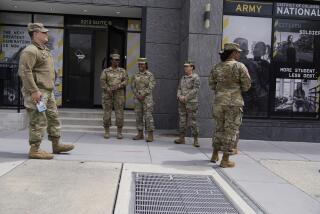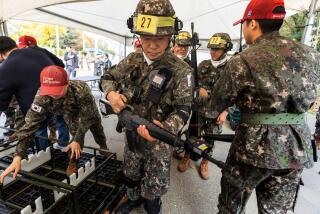Indian Army Stages Media Blitz to Lure Junior Officers
- Share via
NEW DELHI, India — Imagine yourself as a commander roaring across the desert in a steel chariot pulled by 12,000 horses.
The Indian army hopes that exciting image and others in a new advertising campaign will attract the 13,000 young men and women it needs to recruit as junior officers.
Finding enough qualified candidates for the officer corps is just one of the problems nagging the army, which with 1.2 million soldiers is the third largest in the world. Morale, up-to-date equipment and decisive leadership are in short supply, experts say.
All the Indian army seems to have in abundance is threats-- Pakistan, China and a host of home-grown groups fighting for ethnic or religious homelands.
Lt. Gen. K.K. Hazari, a retired army vice chief of staff who runs a think tank on security affairs, considers the last category of enemies one of the most serious.
Internal security duties rob time, money and soldiers that should be devoted to defending the nation against external enemies, he says.
The army fought four wars in the first half of India’s 50 years of independence from Britain--three with Pakistan, one with China. But it has spent the last two decades fighting some of India’s own people.
Punjab and Kashmir in the north and Assam, Nagaland, Mizoram and Manipur in the remote northeast--a quarter of India’s 24 states--have been racked by insurgencies waged by dozens of separatist groups. More than 25,000 people have died in the fighting.
Although the Home Ministry has its own 500,000-man paramilitary force for policing and internal security, it relies on the army as the first resort for fighting rebellions.
The army is also often called on to control Hindu-Muslim riots. And last year, a federal investigator sought the army’s help in arresting a powerful elected official in eastern Bihar state allegedly involved in a bribery scandal.
Looking for alternatives in the early 1990s, the government set up the 30,000-soldier Rashtriya Rifles to fight insurgents, reasoning that would free the rest of the army for more traditional defense duties.
But that force’s future is in doubt because of a dispute between the Home Ministry and the army over who should pay for it, says a defense analyst, Rahul Bedi.
Bedi says the pressures of fighting rebellions has lowered morale in the enlisted ranks. Last year, 17 officers and soldiers were shot dead by their own colleagues in Kashmir, Nagaland and Manipur.
Morale also is being hurt by poor leadership abilities among officers, Bedi and other experts say.
Experienced officers are leaving, and good replacements are hard to come by. Free-market reforms have created better opportunities in the private sector for bright young people.
A lieutenant in the Indian army gets a monthly salary equivalent to $230 plus food and a housing allowance that brings total compensation to about $310. A comparable job with a multinational corporation or a leading Indian company could earn salary and allowances up to 2 1/2 times more.
Hazari, the retired general, says good officers might see a brighter future if the army had a closer relationship with India’s decision-makers. Instead, generals for the most part have to relay their concerns through bureaucrats.
Officials proposed in the late 1980s that India create a body similar to the U.S. National Security Council, where politicians, bureaucrats and military leaders could sit together to make defense policy. But nothing has been done.
Hazari says generals need more input on spending in order to defend India against its main potential enemies, China and Pakistan.
The government’s defense allocation of just under $8 billion in 1997 was 2.3% of the gross domestic product. Pakistan and China spend 6.9% and 5.6%, respectively, on defense, Indian military officials say.
Growing job opportunities from India’s economic reforms also have cut into the number of young men willing to join the army as low-paid enlisted soldiers.
But that is seen as less of a problem because the government is considering reducing the overall size of the army by 50,000 soldiers to free up money for modernization.
More to Read
Sign up for Essential California
The most important California stories and recommendations in your inbox every morning.
You may occasionally receive promotional content from the Los Angeles Times.










